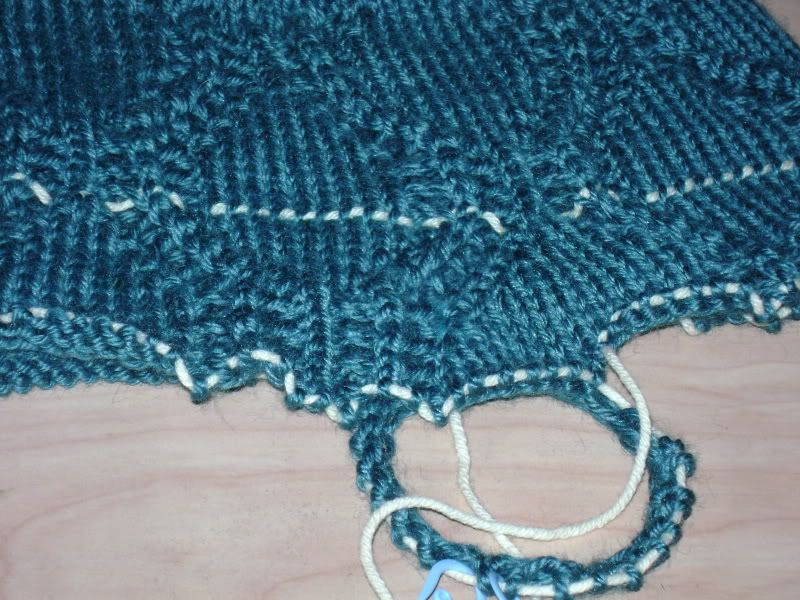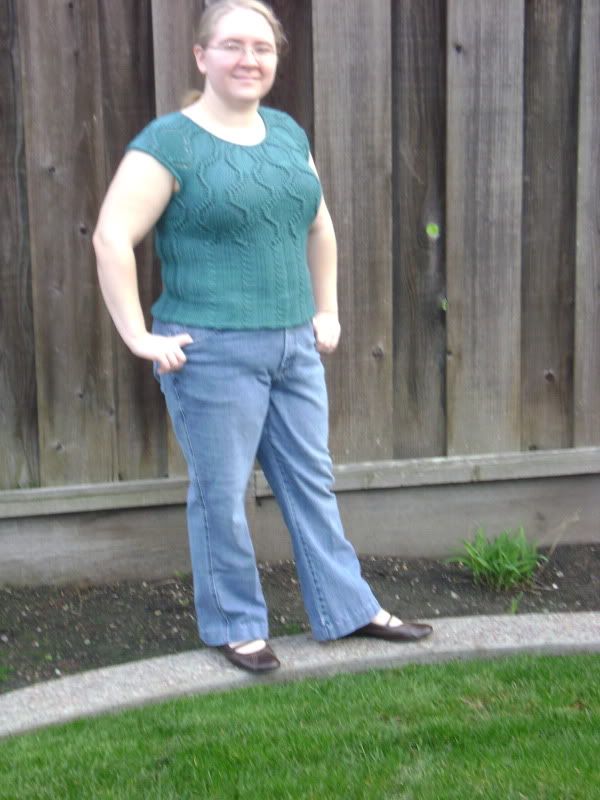Amongst the techniques I'm going to use in it are bust darts. These should provide enough space for the girls up front without having it baggy and saggy everywhere else on me. The size of the girls coupled with my particular frame proportions means that I really need the darts to make anything fit. (Store-bought clothes can be baggy in the shoulders/back and too small in the bust at the same time on me. Not fun.) There are two types of bust darts in the knitting/crochet world: Vertical Bust Darts (VBDs for short) and Horizontal Bust Darts (HBDs for short).
VBDs are where stitches are added (via increases, usually) to the front chest part of a top to create a wider fabric to go around the girls, then gotten rid of (decreased away, usually) once we're past the girls. HBDs are usually formed by using short rows, and they make the front part of the top longer than the back, to counteract the way tops will ride up in the front on women with big girls (because the girls take up extra length as well as width).
As I was knitting Arbor, I found that I only needed to do VBDs. I had planned on doing both kinds, but the HBDs really were unnecessary.
Technical Notes
I needed to increase 7 stitches on each side. For the increases, I used a pair of increases that Knitting Help used to have on their site, called Right/Left Lifted Increases. Unfortunately, Knitting Help seems to no longer have the instructions for them (or indeed, any mention of them at all) on their website. TECHknitting has instructions for what I learned as the Right Lifted Increase (RLI for short) on her blog, though. And here's how to do the Left Lifted Increase (LLI) using TECHknitting's color shorthand from the RLI pictures: knit into the green stitch and drop it off of the needle, reach down and pull the left side of the red stitch onto the left needle, then knit into the red stitch, dropping the red stitch off of the needle. This forms the exact opposite of the RLI.
In order to try to make what I did understandable, I'm going to refer to each stitch column in the lace chart by number (1 being the rightmost column in the lace and 20 being the leftmost column), and the columns added-in by the increases will be labeled with a letter in addition to the number of the column they came from (i.e. 1, 2, 3, 3a, 4, 5, 6... with 3a being from column 3). I am also using all standard abbreviations as they appear in the pattern, and so will only explain the shorthand I'm adding in myself. The instructions will be a lot clearer if you have the pattern in front of you, so if you don't already have a copy go click on the link up in the first sentence of this post and download a copy--it's free!
Now, I was following the instructions listed as XS, except that I ended up with a M over the widest part of my bust, then decreased back down to an XS in the front by the time it reached the cable rib.
Directions
Follow the cast-on directions for the XS yoke. When you reach the first time for row 1 of the lace chart (as opposed to 1a), you start the VBD increases.
Row1: Knit the first 3 lace repeats as the chart shows. On the forth repeat (from now on called the Right Dart Lace or RDL), do a LLI on stitch 11 (creating 11a). Knit two more lace repeats as the chart shows. On the seventh repeat (from now on called the Left Dart Lace or LDL), do a RLI on stitch 11 (creating 11b). Finish off the last three lace repeats as the chart shows.
Row 2 and all other even rows: Follow the lace pattern as established, purling the purls an knitting everything else.
Row3: In RDL, do a LLI on stitch 11a (creating 11c). In LDL, do a RLI on stitch 11b (creating 11d).
Row5: In RDL, do a LLI on stitch 12 (creating 12a). In LDL, do a RLI on stitch 10 (creating 10a).
Row7: In RDL, do a LLI on stitch 13 (creating 13a). In LDL, do a RLI on stitch 9 (creating 9a).
Row9: In RDL, do a LLI on stitch 14 (creating 14a). In LDL, do a RLI on stitch 8 (creating 8a).
Row11: In RDL, do a LLI on stitch 15 (creating 15a). In LDL, do a RLI on stitch 7 (creating 7a).
Row 13: In RDL, do a LLI on stitch 15a (creating 15b). In LDL, do a RLI on stitch 7a (creating 7b). RDL and LDL should now contain 27 stitches each.
Row14 is where the stitches for the arm are put on waste yarn, and more stitches are cast on for underneath the arm. The remaining increases are casted on here. So instead of the way it's writting in the pattern, instead it goes:
K 27 sts in pattern, slip 46 sts onto a piece of waste yarn, cast on 7 sts, pm, cast on 1 st, pm, cast on 11 sts, K 68 sts in pattern, slip 46 sts onto a piece of waste yarn, cast on 11 sts, pm, cast on 1 st, pm, cast on 7 sts, K 27 stitches. There will now be 160 stitches on the needle. The single stitches sandwiched between stitch markers are purled each round, and I dropped them to do EZ's faux seam technique on them. The stitches that form the first and last 34 stitches are the back, and match the count for an XS. The 90 stitches in the center (between the two seam stitches) are the front, and match the stitch count for a M.
The increases should look something like this:

Follow the bodice directions for 10 rows. The next row should match up with row 25 on the lace chart. From there down to the cable ribbing, knit the back panels as the pattern directs and purl the seam stitches. The modified instructions here will only mention the front "half" of the top.
Row25: K2tog, knit in established pattern until the last two stitches of the front, SSK.
Row26 and all other even rows: Knit in established pattern.
Row27: K2tog, knit in established pattern until the last two stitches of the front, SSK.
Row1 and all odd rows through 17: Decrease one stitch at the edges of the front panel as established. (A right-leaning decrease on the right side and a left-leaning decrease on the left side.) Row 17 should end with 68 stitches in the front panel, matching the number in the back panel.
Follow the directions for an XS from here on out.
And here's a picture of the finished top!
